Cognitive Behavioral Therapy vs. Person Centred Therapy
VerifiedAdded on 2023/06/10
|13
|3761
|346
AI Summary
This paper compares and contrasts the application of Cognitive behavioral therapy and Person-Centred Therapy by underpinning the underlying assumptions and goals of either models; therapeutic relationships between caregivers and patients; and key approaches of and processes of change as well as limitations of either therapies.
Contribute Materials
Your contribution can guide someone’s learning journey. Share your
documents today.
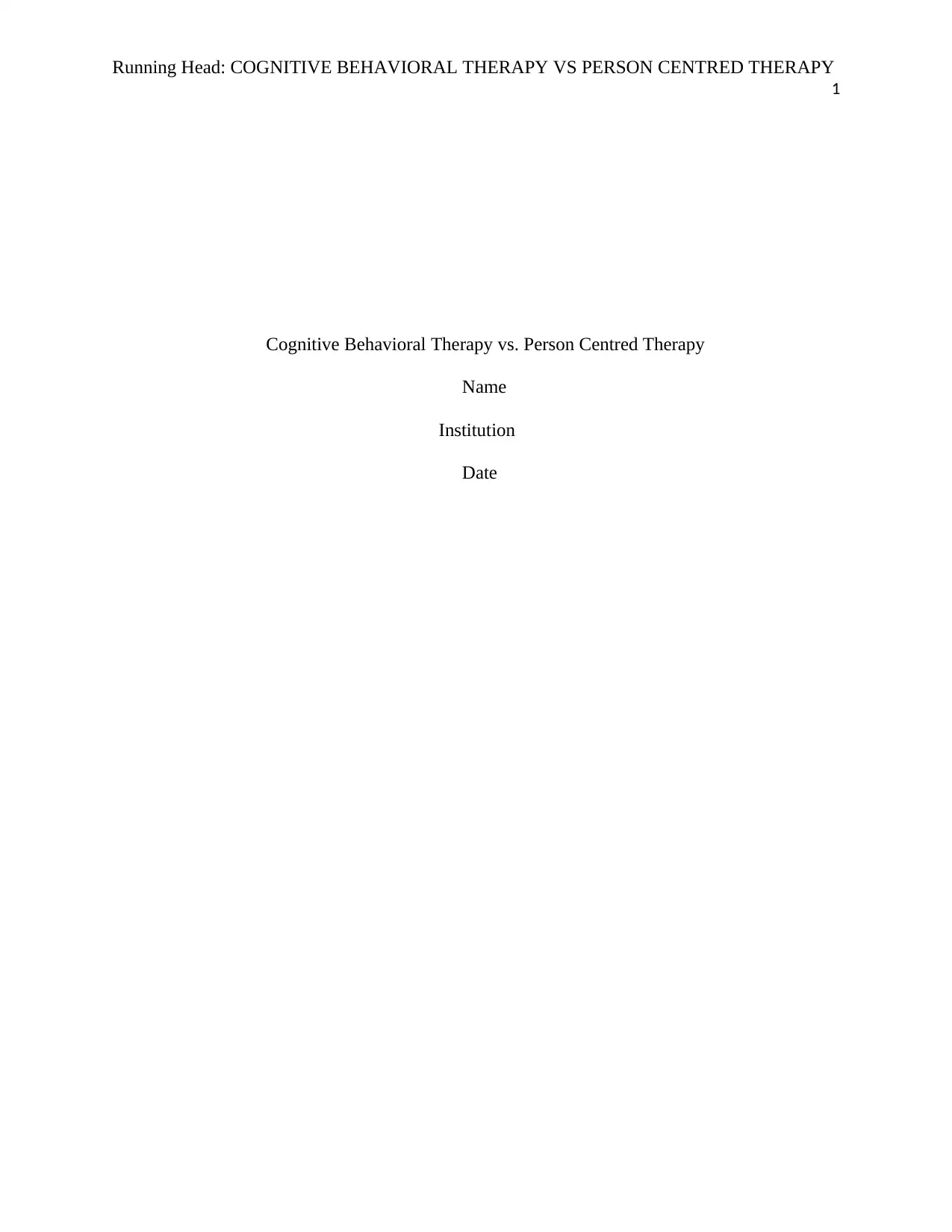
Running Head: COGNITIVE BEHAVIORAL THERAPY VS PERSON CENTRED THERAPY
1
Cognitive Behavioral Therapy vs. Person Centred Therapy
Name
Institution
Date
1
Cognitive Behavioral Therapy vs. Person Centred Therapy
Name
Institution
Date
Secure Best Marks with AI Grader
Need help grading? Try our AI Grader for instant feedback on your assignments.
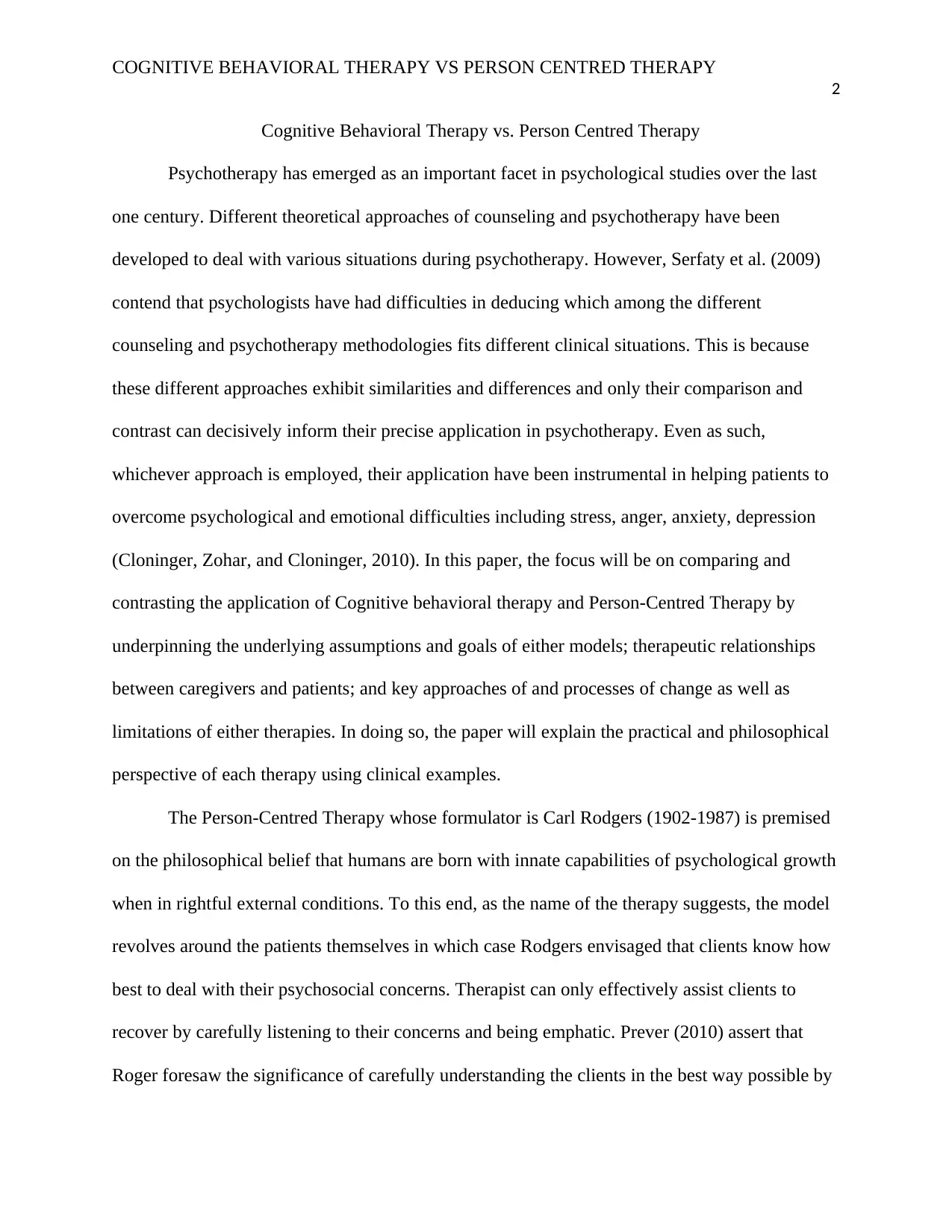
COGNITIVE BEHAVIORAL THERAPY VS PERSON CENTRED THERAPY
2
Cognitive Behavioral Therapy vs. Person Centred Therapy
Psychotherapy has emerged as an important facet in psychological studies over the last
one century. Different theoretical approaches of counseling and psychotherapy have been
developed to deal with various situations during psychotherapy. However, Serfaty et al. (2009)
contend that psychologists have had difficulties in deducing which among the different
counseling and psychotherapy methodologies fits different clinical situations. This is because
these different approaches exhibit similarities and differences and only their comparison and
contrast can decisively inform their precise application in psychotherapy. Even as such,
whichever approach is employed, their application have been instrumental in helping patients to
overcome psychological and emotional difficulties including stress, anger, anxiety, depression
(Cloninger, Zohar, and Cloninger, 2010). In this paper, the focus will be on comparing and
contrasting the application of Cognitive behavioral therapy and Person-Centred Therapy by
underpinning the underlying assumptions and goals of either models; therapeutic relationships
between caregivers and patients; and key approaches of and processes of change as well as
limitations of either therapies. In doing so, the paper will explain the practical and philosophical
perspective of each therapy using clinical examples.
The Person-Centred Therapy whose formulator is Carl Rodgers (1902-1987) is premised
on the philosophical belief that humans are born with innate capabilities of psychological growth
when in rightful external conditions. To this end, as the name of the therapy suggests, the model
revolves around the patients themselves in which case Rodgers envisaged that clients know how
best to deal with their psychosocial concerns. Therapist can only effectively assist clients to
recover by carefully listening to their concerns and being emphatic. Prever (2010) assert that
Roger foresaw the significance of carefully understanding the clients in the best way possible by
2
Cognitive Behavioral Therapy vs. Person Centred Therapy
Psychotherapy has emerged as an important facet in psychological studies over the last
one century. Different theoretical approaches of counseling and psychotherapy have been
developed to deal with various situations during psychotherapy. However, Serfaty et al. (2009)
contend that psychologists have had difficulties in deducing which among the different
counseling and psychotherapy methodologies fits different clinical situations. This is because
these different approaches exhibit similarities and differences and only their comparison and
contrast can decisively inform their precise application in psychotherapy. Even as such,
whichever approach is employed, their application have been instrumental in helping patients to
overcome psychological and emotional difficulties including stress, anger, anxiety, depression
(Cloninger, Zohar, and Cloninger, 2010). In this paper, the focus will be on comparing and
contrasting the application of Cognitive behavioral therapy and Person-Centred Therapy by
underpinning the underlying assumptions and goals of either models; therapeutic relationships
between caregivers and patients; and key approaches of and processes of change as well as
limitations of either therapies. In doing so, the paper will explain the practical and philosophical
perspective of each therapy using clinical examples.
The Person-Centred Therapy whose formulator is Carl Rodgers (1902-1987) is premised
on the philosophical belief that humans are born with innate capabilities of psychological growth
when in rightful external conditions. To this end, as the name of the therapy suggests, the model
revolves around the patients themselves in which case Rodgers envisaged that clients know how
best to deal with their psychosocial concerns. Therapist can only effectively assist clients to
recover by carefully listening to their concerns and being emphatic. Prever (2010) assert that
Roger foresaw the significance of carefully understanding the clients in the best way possible by
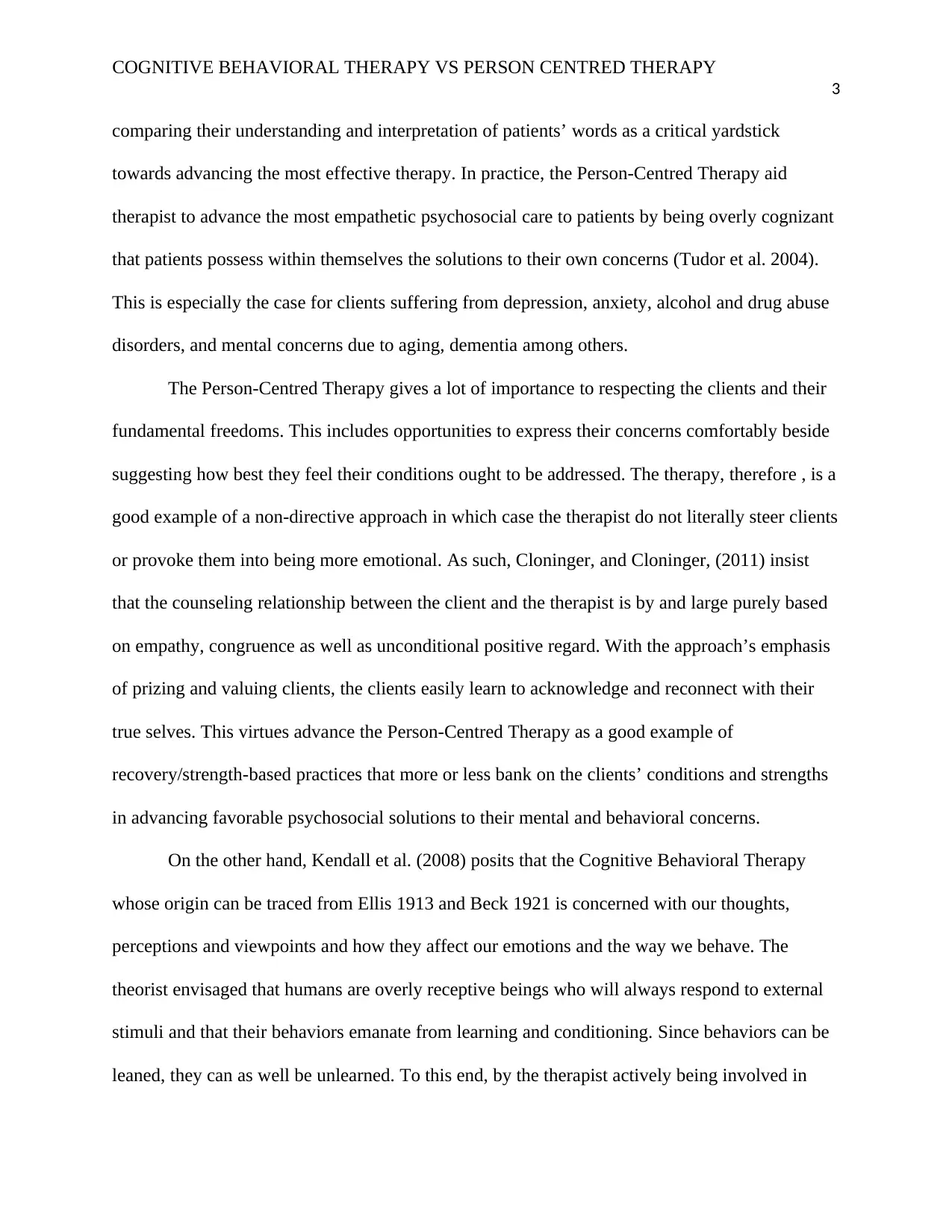
COGNITIVE BEHAVIORAL THERAPY VS PERSON CENTRED THERAPY
3
comparing their understanding and interpretation of patients’ words as a critical yardstick
towards advancing the most effective therapy. In practice, the Person-Centred Therapy aid
therapist to advance the most empathetic psychosocial care to patients by being overly cognizant
that patients possess within themselves the solutions to their own concerns (Tudor et al. 2004).
This is especially the case for clients suffering from depression, anxiety, alcohol and drug abuse
disorders, and mental concerns due to aging, dementia among others.
The Person-Centred Therapy gives a lot of importance to respecting the clients and their
fundamental freedoms. This includes opportunities to express their concerns comfortably beside
suggesting how best they feel their conditions ought to be addressed. The therapy, therefore , is a
good example of a non-directive approach in which case the therapist do not literally steer clients
or provoke them into being more emotional. As such, Cloninger, and Cloninger, (2011) insist
that the counseling relationship between the client and the therapist is by and large purely based
on empathy, congruence as well as unconditional positive regard. With the approach’s emphasis
of prizing and valuing clients, the clients easily learn to acknowledge and reconnect with their
true selves. This virtues advance the Person-Centred Therapy as a good example of
recovery/strength-based practices that more or less bank on the clients’ conditions and strengths
in advancing favorable psychosocial solutions to their mental and behavioral concerns.
On the other hand, Kendall et al. (2008) posits that the Cognitive Behavioral Therapy
whose origin can be traced from Ellis 1913 and Beck 1921 is concerned with our thoughts,
perceptions and viewpoints and how they affect our emotions and the way we behave. The
theorist envisaged that humans are overly receptive beings who will always respond to external
stimuli and that their behaviors emanate from learning and conditioning. Since behaviors can be
leaned, they can as well be unlearned. To this end, by the therapist actively being involved in
3
comparing their understanding and interpretation of patients’ words as a critical yardstick
towards advancing the most effective therapy. In practice, the Person-Centred Therapy aid
therapist to advance the most empathetic psychosocial care to patients by being overly cognizant
that patients possess within themselves the solutions to their own concerns (Tudor et al. 2004).
This is especially the case for clients suffering from depression, anxiety, alcohol and drug abuse
disorders, and mental concerns due to aging, dementia among others.
The Person-Centred Therapy gives a lot of importance to respecting the clients and their
fundamental freedoms. This includes opportunities to express their concerns comfortably beside
suggesting how best they feel their conditions ought to be addressed. The therapy, therefore , is a
good example of a non-directive approach in which case the therapist do not literally steer clients
or provoke them into being more emotional. As such, Cloninger, and Cloninger, (2011) insist
that the counseling relationship between the client and the therapist is by and large purely based
on empathy, congruence as well as unconditional positive regard. With the approach’s emphasis
of prizing and valuing clients, the clients easily learn to acknowledge and reconnect with their
true selves. This virtues advance the Person-Centred Therapy as a good example of
recovery/strength-based practices that more or less bank on the clients’ conditions and strengths
in advancing favorable psychosocial solutions to their mental and behavioral concerns.
On the other hand, Kendall et al. (2008) posits that the Cognitive Behavioral Therapy
whose origin can be traced from Ellis 1913 and Beck 1921 is concerned with our thoughts,
perceptions and viewpoints and how they affect our emotions and the way we behave. The
theorist envisaged that humans are overly receptive beings who will always respond to external
stimuli and that their behaviors emanate from learning and conditioning. Since behaviors can be
leaned, they can as well be unlearned. To this end, by the therapist actively being involved in
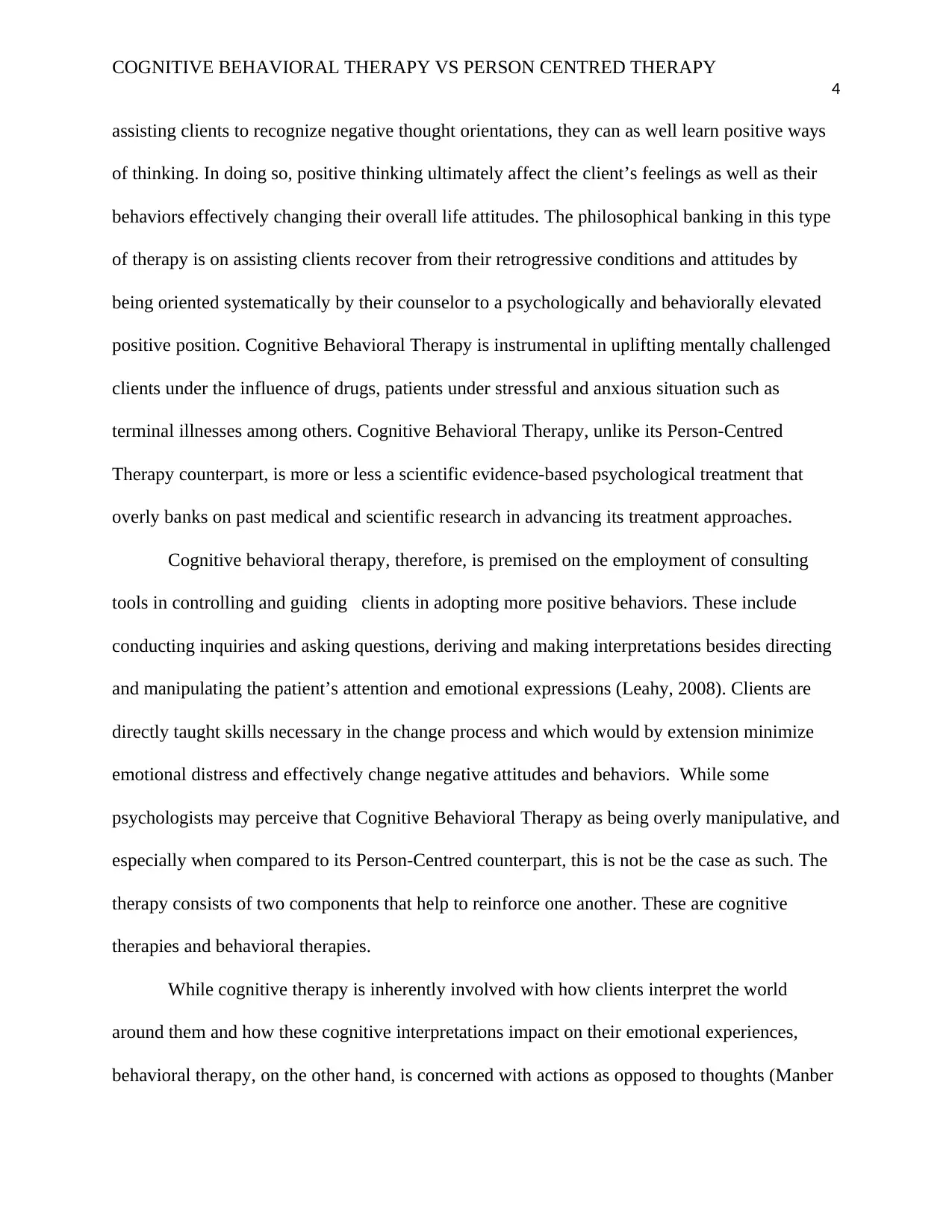
COGNITIVE BEHAVIORAL THERAPY VS PERSON CENTRED THERAPY
4
assisting clients to recognize negative thought orientations, they can as well learn positive ways
of thinking. In doing so, positive thinking ultimately affect the client’s feelings as well as their
behaviors effectively changing their overall life attitudes. The philosophical banking in this type
of therapy is on assisting clients recover from their retrogressive conditions and attitudes by
being oriented systematically by their counselor to a psychologically and behaviorally elevated
positive position. Cognitive Behavioral Therapy is instrumental in uplifting mentally challenged
clients under the influence of drugs, patients under stressful and anxious situation such as
terminal illnesses among others. Cognitive Behavioral Therapy, unlike its Person-Centred
Therapy counterpart, is more or less a scientific evidence-based psychological treatment that
overly banks on past medical and scientific research in advancing its treatment approaches.
Cognitive behavioral therapy, therefore, is premised on the employment of consulting
tools in controlling and guiding clients in adopting more positive behaviors. These include
conducting inquiries and asking questions, deriving and making interpretations besides directing
and manipulating the patient’s attention and emotional expressions (Leahy, 2008). Clients are
directly taught skills necessary in the change process and which would by extension minimize
emotional distress and effectively change negative attitudes and behaviors. While some
psychologists may perceive that Cognitive Behavioral Therapy as being overly manipulative, and
especially when compared to its Person-Centred counterpart, this is not be the case as such. The
therapy consists of two components that help to reinforce one another. These are cognitive
therapies and behavioral therapies.
While cognitive therapy is inherently involved with how clients interpret the world
around them and how these cognitive interpretations impact on their emotional experiences,
behavioral therapy, on the other hand, is concerned with actions as opposed to thoughts (Manber
4
assisting clients to recognize negative thought orientations, they can as well learn positive ways
of thinking. In doing so, positive thinking ultimately affect the client’s feelings as well as their
behaviors effectively changing their overall life attitudes. The philosophical banking in this type
of therapy is on assisting clients recover from their retrogressive conditions and attitudes by
being oriented systematically by their counselor to a psychologically and behaviorally elevated
positive position. Cognitive Behavioral Therapy is instrumental in uplifting mentally challenged
clients under the influence of drugs, patients under stressful and anxious situation such as
terminal illnesses among others. Cognitive Behavioral Therapy, unlike its Person-Centred
Therapy counterpart, is more or less a scientific evidence-based psychological treatment that
overly banks on past medical and scientific research in advancing its treatment approaches.
Cognitive behavioral therapy, therefore, is premised on the employment of consulting
tools in controlling and guiding clients in adopting more positive behaviors. These include
conducting inquiries and asking questions, deriving and making interpretations besides directing
and manipulating the patient’s attention and emotional expressions (Leahy, 2008). Clients are
directly taught skills necessary in the change process and which would by extension minimize
emotional distress and effectively change negative attitudes and behaviors. While some
psychologists may perceive that Cognitive Behavioral Therapy as being overly manipulative, and
especially when compared to its Person-Centred counterpart, this is not be the case as such. The
therapy consists of two components that help to reinforce one another. These are cognitive
therapies and behavioral therapies.
While cognitive therapy is inherently involved with how clients interpret the world
around them and how these cognitive interpretations impact on their emotional experiences,
behavioral therapy, on the other hand, is concerned with actions as opposed to thoughts (Manber
Secure Best Marks with AI Grader
Need help grading? Try our AI Grader for instant feedback on your assignments.
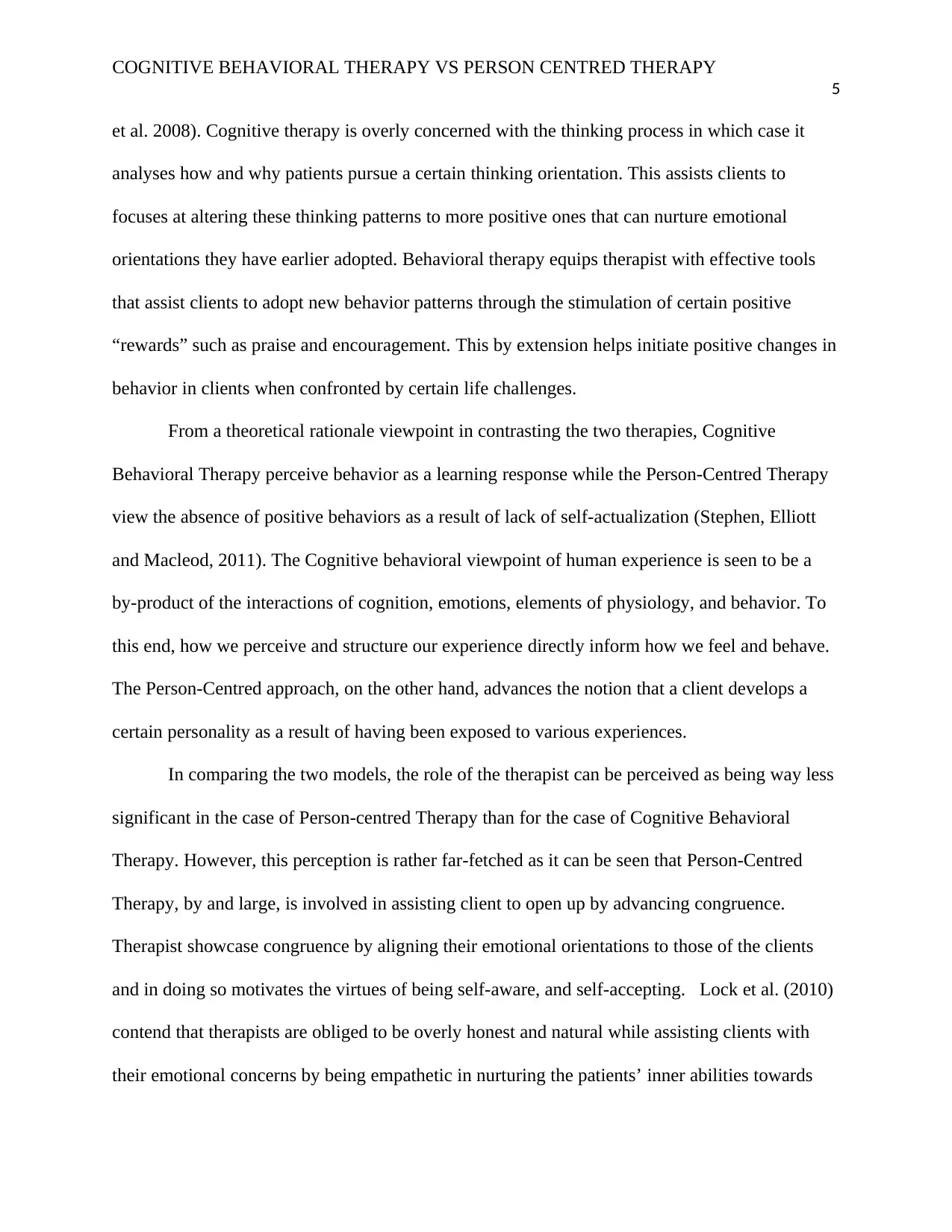
COGNITIVE BEHAVIORAL THERAPY VS PERSON CENTRED THERAPY
5
et al. 2008). Cognitive therapy is overly concerned with the thinking process in which case it
analyses how and why patients pursue a certain thinking orientation. This assists clients to
focuses at altering these thinking patterns to more positive ones that can nurture emotional
orientations they have earlier adopted. Behavioral therapy equips therapist with effective tools
that assist clients to adopt new behavior patterns through the stimulation of certain positive
“rewards” such as praise and encouragement. This by extension helps initiate positive changes in
behavior in clients when confronted by certain life challenges.
From a theoretical rationale viewpoint in contrasting the two therapies, Cognitive
Behavioral Therapy perceive behavior as a learning response while the Person-Centred Therapy
view the absence of positive behaviors as a result of lack of self-actualization (Stephen, Elliott
and Macleod, 2011). The Cognitive behavioral viewpoint of human experience is seen to be a
by-product of the interactions of cognition, emotions, elements of physiology, and behavior. To
this end, how we perceive and structure our experience directly inform how we feel and behave.
The Person-Centred approach, on the other hand, advances the notion that a client develops a
certain personality as a result of having been exposed to various experiences.
In comparing the two models, the role of the therapist can be perceived as being way less
significant in the case of Person-centred Therapy than for the case of Cognitive Behavioral
Therapy. However, this perception is rather far-fetched as it can be seen that Person-Centred
Therapy, by and large, is involved in assisting client to open up by advancing congruence.
Therapist showcase congruence by aligning their emotional orientations to those of the clients
and in doing so motivates the virtues of being self-aware, and self-accepting. Lock et al. (2010)
contend that therapists are obliged to be overly honest and natural while assisting clients with
their emotional concerns by being empathetic in nurturing the patients’ inner abilities towards
5
et al. 2008). Cognitive therapy is overly concerned with the thinking process in which case it
analyses how and why patients pursue a certain thinking orientation. This assists clients to
focuses at altering these thinking patterns to more positive ones that can nurture emotional
orientations they have earlier adopted. Behavioral therapy equips therapist with effective tools
that assist clients to adopt new behavior patterns through the stimulation of certain positive
“rewards” such as praise and encouragement. This by extension helps initiate positive changes in
behavior in clients when confronted by certain life challenges.
From a theoretical rationale viewpoint in contrasting the two therapies, Cognitive
Behavioral Therapy perceive behavior as a learning response while the Person-Centred Therapy
view the absence of positive behaviors as a result of lack of self-actualization (Stephen, Elliott
and Macleod, 2011). The Cognitive behavioral viewpoint of human experience is seen to be a
by-product of the interactions of cognition, emotions, elements of physiology, and behavior. To
this end, how we perceive and structure our experience directly inform how we feel and behave.
The Person-Centred approach, on the other hand, advances the notion that a client develops a
certain personality as a result of having been exposed to various experiences.
In comparing the two models, the role of the therapist can be perceived as being way less
significant in the case of Person-centred Therapy than for the case of Cognitive Behavioral
Therapy. However, this perception is rather far-fetched as it can be seen that Person-Centred
Therapy, by and large, is involved in assisting client to open up by advancing congruence.
Therapist showcase congruence by aligning their emotional orientations to those of the clients
and in doing so motivates the virtues of being self-aware, and self-accepting. Lock et al. (2010)
contend that therapists are obliged to be overly honest and natural while assisting clients with
their emotional concerns by being empathetic in nurturing the patients’ inner abilities towards
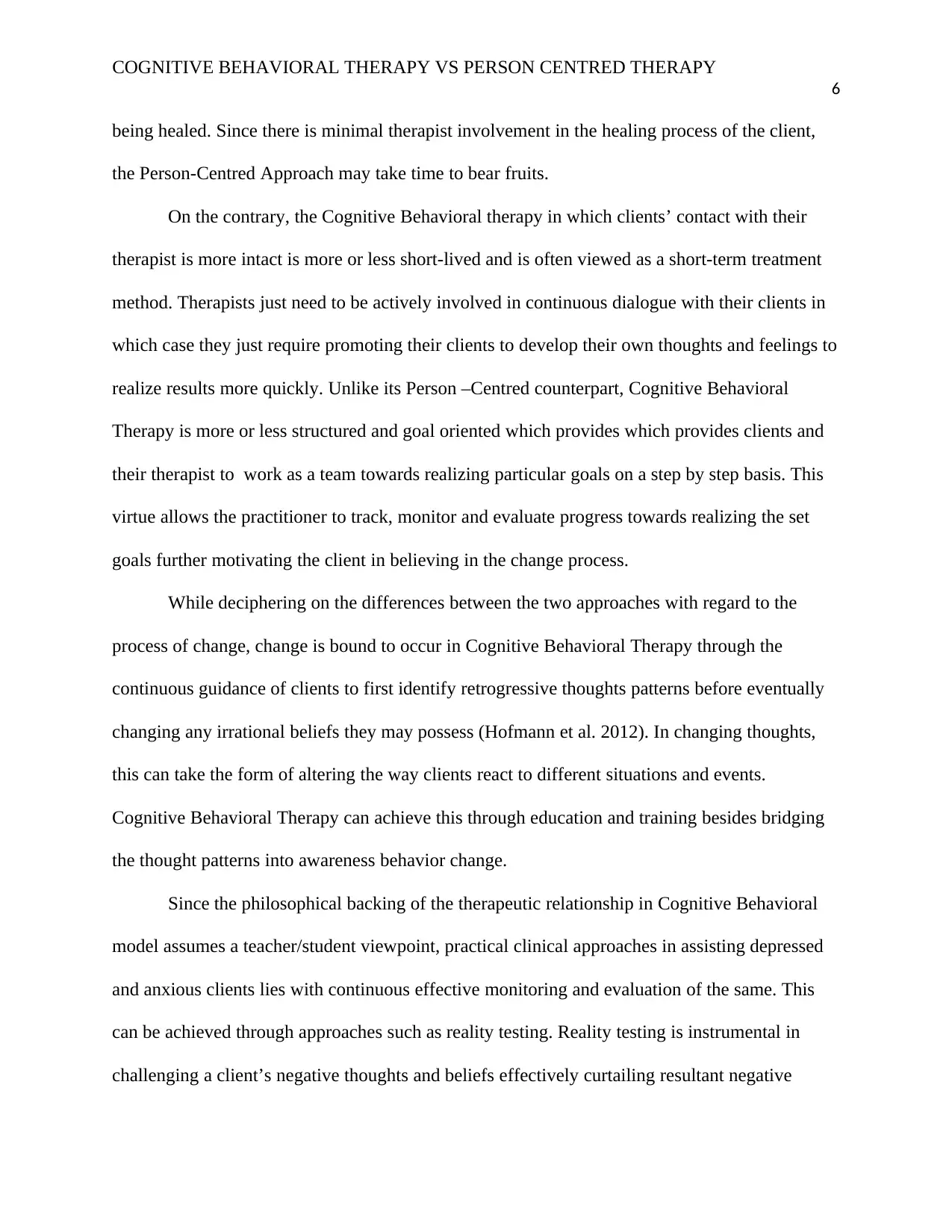
COGNITIVE BEHAVIORAL THERAPY VS PERSON CENTRED THERAPY
6
being healed. Since there is minimal therapist involvement in the healing process of the client,
the Person-Centred Approach may take time to bear fruits.
On the contrary, the Cognitive Behavioral therapy in which clients’ contact with their
therapist is more intact is more or less short-lived and is often viewed as a short-term treatment
method. Therapists just need to be actively involved in continuous dialogue with their clients in
which case they just require promoting their clients to develop their own thoughts and feelings to
realize results more quickly. Unlike its Person –Centred counterpart, Cognitive Behavioral
Therapy is more or less structured and goal oriented which provides which provides clients and
their therapist to work as a team towards realizing particular goals on a step by step basis. This
virtue allows the practitioner to track, monitor and evaluate progress towards realizing the set
goals further motivating the client in believing in the change process.
While deciphering on the differences between the two approaches with regard to the
process of change, change is bound to occur in Cognitive Behavioral Therapy through the
continuous guidance of clients to first identify retrogressive thoughts patterns before eventually
changing any irrational beliefs they may possess (Hofmann et al. 2012). In changing thoughts,
this can take the form of altering the way clients react to different situations and events.
Cognitive Behavioral Therapy can achieve this through education and training besides bridging
the thought patterns into awareness behavior change.
Since the philosophical backing of the therapeutic relationship in Cognitive Behavioral
model assumes a teacher/student viewpoint, practical clinical approaches in assisting depressed
and anxious clients lies with continuous effective monitoring and evaluation of the same. This
can be achieved through approaches such as reality testing. Reality testing is instrumental in
challenging a client’s negative thoughts and beliefs effectively curtailing resultant negative
6
being healed. Since there is minimal therapist involvement in the healing process of the client,
the Person-Centred Approach may take time to bear fruits.
On the contrary, the Cognitive Behavioral therapy in which clients’ contact with their
therapist is more intact is more or less short-lived and is often viewed as a short-term treatment
method. Therapists just need to be actively involved in continuous dialogue with their clients in
which case they just require promoting their clients to develop their own thoughts and feelings to
realize results more quickly. Unlike its Person –Centred counterpart, Cognitive Behavioral
Therapy is more or less structured and goal oriented which provides which provides clients and
their therapist to work as a team towards realizing particular goals on a step by step basis. This
virtue allows the practitioner to track, monitor and evaluate progress towards realizing the set
goals further motivating the client in believing in the change process.
While deciphering on the differences between the two approaches with regard to the
process of change, change is bound to occur in Cognitive Behavioral Therapy through the
continuous guidance of clients to first identify retrogressive thoughts patterns before eventually
changing any irrational beliefs they may possess (Hofmann et al. 2012). In changing thoughts,
this can take the form of altering the way clients react to different situations and events.
Cognitive Behavioral Therapy can achieve this through education and training besides bridging
the thought patterns into awareness behavior change.
Since the philosophical backing of the therapeutic relationship in Cognitive Behavioral
model assumes a teacher/student viewpoint, practical clinical approaches in assisting depressed
and anxious clients lies with continuous effective monitoring and evaluation of the same. This
can be achieved through approaches such as reality testing. Reality testing is instrumental in
challenging a client’s negative thoughts and beliefs effectively curtailing resultant negative
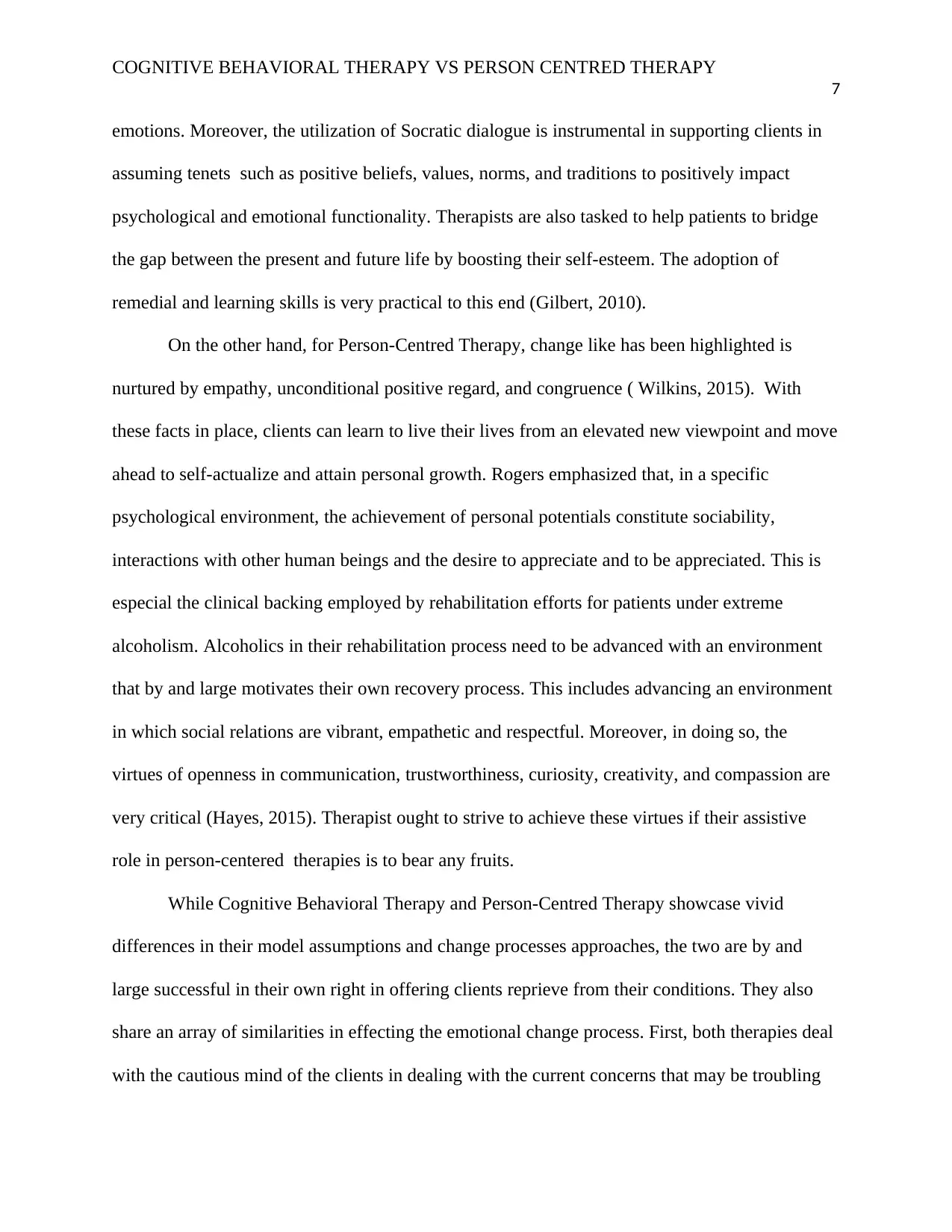
COGNITIVE BEHAVIORAL THERAPY VS PERSON CENTRED THERAPY
7
emotions. Moreover, the utilization of Socratic dialogue is instrumental in supporting clients in
assuming tenets such as positive beliefs, values, norms, and traditions to positively impact
psychological and emotional functionality. Therapists are also tasked to help patients to bridge
the gap between the present and future life by boosting their self-esteem. The adoption of
remedial and learning skills is very practical to this end (Gilbert, 2010).
On the other hand, for Person-Centred Therapy, change like has been highlighted is
nurtured by empathy, unconditional positive regard, and congruence ( Wilkins, 2015). With
these facts in place, clients can learn to live their lives from an elevated new viewpoint and move
ahead to self-actualize and attain personal growth. Rogers emphasized that, in a specific
psychological environment, the achievement of personal potentials constitute sociability,
interactions with other human beings and the desire to appreciate and to be appreciated. This is
especial the clinical backing employed by rehabilitation efforts for patients under extreme
alcoholism. Alcoholics in their rehabilitation process need to be advanced with an environment
that by and large motivates their own recovery process. This includes advancing an environment
in which social relations are vibrant, empathetic and respectful. Moreover, in doing so, the
virtues of openness in communication, trustworthiness, curiosity, creativity, and compassion are
very critical (Hayes, 2015). Therapist ought to strive to achieve these virtues if their assistive
role in person-centered therapies is to bear any fruits.
While Cognitive Behavioral Therapy and Person-Centred Therapy showcase vivid
differences in their model assumptions and change processes approaches, the two are by and
large successful in their own right in offering clients reprieve from their conditions. They also
share an array of similarities in effecting the emotional change process. First, both therapies deal
with the cautious mind of the clients in dealing with the current concerns that may be troubling
7
emotions. Moreover, the utilization of Socratic dialogue is instrumental in supporting clients in
assuming tenets such as positive beliefs, values, norms, and traditions to positively impact
psychological and emotional functionality. Therapists are also tasked to help patients to bridge
the gap between the present and future life by boosting their self-esteem. The adoption of
remedial and learning skills is very practical to this end (Gilbert, 2010).
On the other hand, for Person-Centred Therapy, change like has been highlighted is
nurtured by empathy, unconditional positive regard, and congruence ( Wilkins, 2015). With
these facts in place, clients can learn to live their lives from an elevated new viewpoint and move
ahead to self-actualize and attain personal growth. Rogers emphasized that, in a specific
psychological environment, the achievement of personal potentials constitute sociability,
interactions with other human beings and the desire to appreciate and to be appreciated. This is
especial the clinical backing employed by rehabilitation efforts for patients under extreme
alcoholism. Alcoholics in their rehabilitation process need to be advanced with an environment
that by and large motivates their own recovery process. This includes advancing an environment
in which social relations are vibrant, empathetic and respectful. Moreover, in doing so, the
virtues of openness in communication, trustworthiness, curiosity, creativity, and compassion are
very critical (Hayes, 2015). Therapist ought to strive to achieve these virtues if their assistive
role in person-centered therapies is to bear any fruits.
While Cognitive Behavioral Therapy and Person-Centred Therapy showcase vivid
differences in their model assumptions and change processes approaches, the two are by and
large successful in their own right in offering clients reprieve from their conditions. They also
share an array of similarities in effecting the emotional change process. First, both therapies deal
with the cautious mind of the clients in dealing with the current concerns that may be troubling
Paraphrase This Document
Need a fresh take? Get an instant paraphrase of this document with our AI Paraphraser
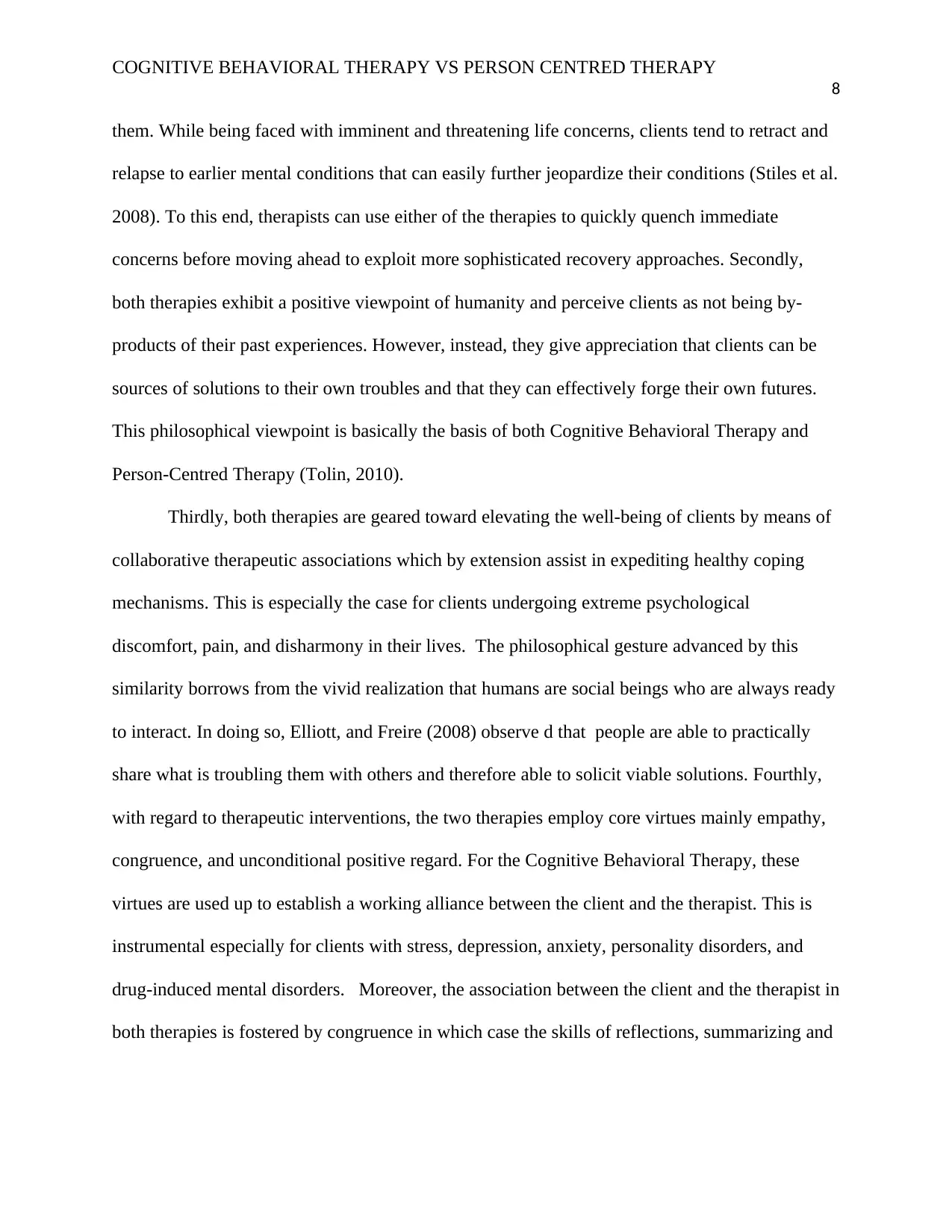
COGNITIVE BEHAVIORAL THERAPY VS PERSON CENTRED THERAPY
8
them. While being faced with imminent and threatening life concerns, clients tend to retract and
relapse to earlier mental conditions that can easily further jeopardize their conditions (Stiles et al.
2008). To this end, therapists can use either of the therapies to quickly quench immediate
concerns before moving ahead to exploit more sophisticated recovery approaches. Secondly,
both therapies exhibit a positive viewpoint of humanity and perceive clients as not being by-
products of their past experiences. However, instead, they give appreciation that clients can be
sources of solutions to their own troubles and that they can effectively forge their own futures.
This philosophical viewpoint is basically the basis of both Cognitive Behavioral Therapy and
Person-Centred Therapy (Tolin, 2010).
Thirdly, both therapies are geared toward elevating the well-being of clients by means of
collaborative therapeutic associations which by extension assist in expediting healthy coping
mechanisms. This is especially the case for clients undergoing extreme psychological
discomfort, pain, and disharmony in their lives. The philosophical gesture advanced by this
similarity borrows from the vivid realization that humans are social beings who are always ready
to interact. In doing so, Elliott, and Freire (2008) observe d that people are able to practically
share what is troubling them with others and therefore able to solicit viable solutions. Fourthly,
with regard to therapeutic interventions, the two therapies employ core virtues mainly empathy,
congruence, and unconditional positive regard. For the Cognitive Behavioral Therapy, these
virtues are used up to establish a working alliance between the client and the therapist. This is
instrumental especially for clients with stress, depression, anxiety, personality disorders, and
drug-induced mental disorders. Moreover, the association between the client and the therapist in
both therapies is fostered by congruence in which case the skills of reflections, summarizing and
8
them. While being faced with imminent and threatening life concerns, clients tend to retract and
relapse to earlier mental conditions that can easily further jeopardize their conditions (Stiles et al.
2008). To this end, therapists can use either of the therapies to quickly quench immediate
concerns before moving ahead to exploit more sophisticated recovery approaches. Secondly,
both therapies exhibit a positive viewpoint of humanity and perceive clients as not being by-
products of their past experiences. However, instead, they give appreciation that clients can be
sources of solutions to their own troubles and that they can effectively forge their own futures.
This philosophical viewpoint is basically the basis of both Cognitive Behavioral Therapy and
Person-Centred Therapy (Tolin, 2010).
Thirdly, both therapies are geared toward elevating the well-being of clients by means of
collaborative therapeutic associations which by extension assist in expediting healthy coping
mechanisms. This is especially the case for clients undergoing extreme psychological
discomfort, pain, and disharmony in their lives. The philosophical gesture advanced by this
similarity borrows from the vivid realization that humans are social beings who are always ready
to interact. In doing so, Elliott, and Freire (2008) observe d that people are able to practically
share what is troubling them with others and therefore able to solicit viable solutions. Fourthly,
with regard to therapeutic interventions, the two therapies employ core virtues mainly empathy,
congruence, and unconditional positive regard. For the Cognitive Behavioral Therapy, these
virtues are used up to establish a working alliance between the client and the therapist. This is
instrumental especially for clients with stress, depression, anxiety, personality disorders, and
drug-induced mental disorders. Moreover, the association between the client and the therapist in
both therapies is fostered by congruence in which case the skills of reflections, summarizing and
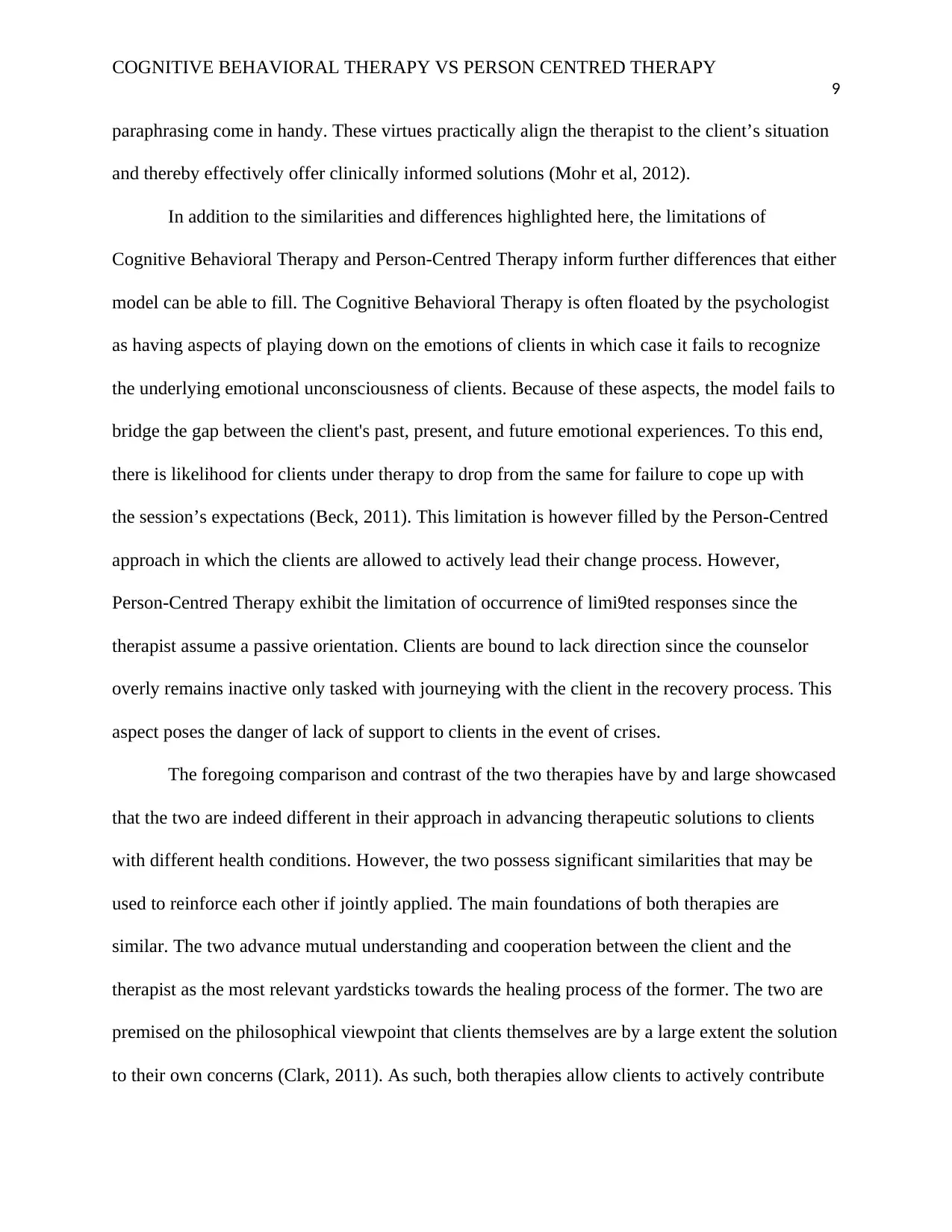
COGNITIVE BEHAVIORAL THERAPY VS PERSON CENTRED THERAPY
9
paraphrasing come in handy. These virtues practically align the therapist to the client’s situation
and thereby effectively offer clinically informed solutions (Mohr et al, 2012).
In addition to the similarities and differences highlighted here, the limitations of
Cognitive Behavioral Therapy and Person-Centred Therapy inform further differences that either
model can be able to fill. The Cognitive Behavioral Therapy is often floated by the psychologist
as having aspects of playing down on the emotions of clients in which case it fails to recognize
the underlying emotional unconsciousness of clients. Because of these aspects, the model fails to
bridge the gap between the client's past, present, and future emotional experiences. To this end,
there is likelihood for clients under therapy to drop from the same for failure to cope up with
the session’s expectations (Beck, 2011). This limitation is however filled by the Person-Centred
approach in which the clients are allowed to actively lead their change process. However,
Person-Centred Therapy exhibit the limitation of occurrence of limi9ted responses since the
therapist assume a passive orientation. Clients are bound to lack direction since the counselor
overly remains inactive only tasked with journeying with the client in the recovery process. This
aspect poses the danger of lack of support to clients in the event of crises.
The foregoing comparison and contrast of the two therapies have by and large showcased
that the two are indeed different in their approach in advancing therapeutic solutions to clients
with different health conditions. However, the two possess significant similarities that may be
used to reinforce each other if jointly applied. The main foundations of both therapies are
similar. The two advance mutual understanding and cooperation between the client and the
therapist as the most relevant yardsticks towards the healing process of the former. The two are
premised on the philosophical viewpoint that clients themselves are by a large extent the solution
to their own concerns (Clark, 2011). As such, both therapies allow clients to actively contribute
9
paraphrasing come in handy. These virtues practically align the therapist to the client’s situation
and thereby effectively offer clinically informed solutions (Mohr et al, 2012).
In addition to the similarities and differences highlighted here, the limitations of
Cognitive Behavioral Therapy and Person-Centred Therapy inform further differences that either
model can be able to fill. The Cognitive Behavioral Therapy is often floated by the psychologist
as having aspects of playing down on the emotions of clients in which case it fails to recognize
the underlying emotional unconsciousness of clients. Because of these aspects, the model fails to
bridge the gap between the client's past, present, and future emotional experiences. To this end,
there is likelihood for clients under therapy to drop from the same for failure to cope up with
the session’s expectations (Beck, 2011). This limitation is however filled by the Person-Centred
approach in which the clients are allowed to actively lead their change process. However,
Person-Centred Therapy exhibit the limitation of occurrence of limi9ted responses since the
therapist assume a passive orientation. Clients are bound to lack direction since the counselor
overly remains inactive only tasked with journeying with the client in the recovery process. This
aspect poses the danger of lack of support to clients in the event of crises.
The foregoing comparison and contrast of the two therapies have by and large showcased
that the two are indeed different in their approach in advancing therapeutic solutions to clients
with different health conditions. However, the two possess significant similarities that may be
used to reinforce each other if jointly applied. The main foundations of both therapies are
similar. The two advance mutual understanding and cooperation between the client and the
therapist as the most relevant yardsticks towards the healing process of the former. The two are
premised on the philosophical viewpoint that clients themselves are by a large extent the solution
to their own concerns (Clark, 2011). As such, both therapies allow clients to actively contribute

COGNITIVE BEHAVIORAL THERAPY VS PERSON CENTRED THERAPY
10
to their healing process and indeed for Person-centred therapy they are supposed to assume a
leading role on the same. To this end, Wilkins, (2015) observe that it is prudent for the therapist
to be properly versed with both therapies in order to be able to choose one over the other
depending with different client’s conditions and nearness regaining control of their own life.
10
to their healing process and indeed for Person-centred therapy they are supposed to assume a
leading role on the same. To this end, Wilkins, (2015) observe that it is prudent for the therapist
to be properly versed with both therapies in order to be able to choose one over the other
depending with different client’s conditions and nearness regaining control of their own life.
Secure Best Marks with AI Grader
Need help grading? Try our AI Grader for instant feedback on your assignments.
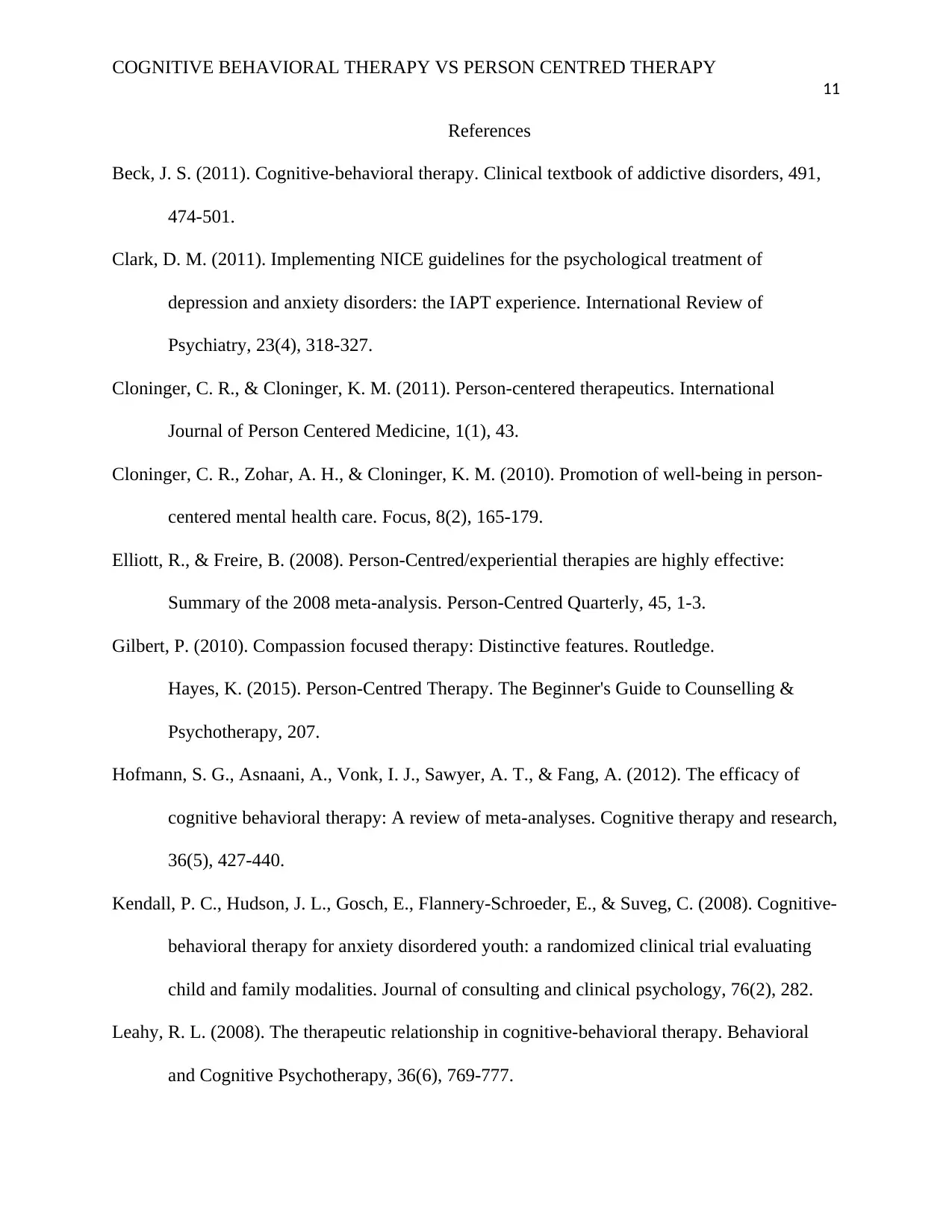
COGNITIVE BEHAVIORAL THERAPY VS PERSON CENTRED THERAPY
11
References
Beck, J. S. (2011). Cognitive-behavioral therapy. Clinical textbook of addictive disorders, 491,
474-501.
Clark, D. M. (2011). Implementing NICE guidelines for the psychological treatment of
depression and anxiety disorders: the IAPT experience. International Review of
Psychiatry, 23(4), 318-327.
Cloninger, C. R., & Cloninger, K. M. (2011). Person-centered therapeutics. International
Journal of Person Centered Medicine, 1(1), 43.
Cloninger, C. R., Zohar, A. H., & Cloninger, K. M. (2010). Promotion of well-being in person-
centered mental health care. Focus, 8(2), 165-179.
Elliott, R., & Freire, B. (2008). Person-Centred/experiential therapies are highly effective:
Summary of the 2008 meta-analysis. Person-Centred Quarterly, 45, 1-3.
Gilbert, P. (2010). Compassion focused therapy: Distinctive features. Routledge.
Hayes, K. (2015). Person-Centred Therapy. The Beginner's Guide to Counselling &
Psychotherapy, 207.
Hofmann, S. G., Asnaani, A., Vonk, I. J., Sawyer, A. T., & Fang, A. (2012). The efficacy of
cognitive behavioral therapy: A review of meta-analyses. Cognitive therapy and research,
36(5), 427-440.
Kendall, P. C., Hudson, J. L., Gosch, E., Flannery-Schroeder, E., & Suveg, C. (2008). Cognitive-
behavioral therapy for anxiety disordered youth: a randomized clinical trial evaluating
child and family modalities. Journal of consulting and clinical psychology, 76(2), 282.
Leahy, R. L. (2008). The therapeutic relationship in cognitive-behavioral therapy. Behavioral
and Cognitive Psychotherapy, 36(6), 769-777.
11
References
Beck, J. S. (2011). Cognitive-behavioral therapy. Clinical textbook of addictive disorders, 491,
474-501.
Clark, D. M. (2011). Implementing NICE guidelines for the psychological treatment of
depression and anxiety disorders: the IAPT experience. International Review of
Psychiatry, 23(4), 318-327.
Cloninger, C. R., & Cloninger, K. M. (2011). Person-centered therapeutics. International
Journal of Person Centered Medicine, 1(1), 43.
Cloninger, C. R., Zohar, A. H., & Cloninger, K. M. (2010). Promotion of well-being in person-
centered mental health care. Focus, 8(2), 165-179.
Elliott, R., & Freire, B. (2008). Person-Centred/experiential therapies are highly effective:
Summary of the 2008 meta-analysis. Person-Centred Quarterly, 45, 1-3.
Gilbert, P. (2010). Compassion focused therapy: Distinctive features. Routledge.
Hayes, K. (2015). Person-Centred Therapy. The Beginner's Guide to Counselling &
Psychotherapy, 207.
Hofmann, S. G., Asnaani, A., Vonk, I. J., Sawyer, A. T., & Fang, A. (2012). The efficacy of
cognitive behavioral therapy: A review of meta-analyses. Cognitive therapy and research,
36(5), 427-440.
Kendall, P. C., Hudson, J. L., Gosch, E., Flannery-Schroeder, E., & Suveg, C. (2008). Cognitive-
behavioral therapy for anxiety disordered youth: a randomized clinical trial evaluating
child and family modalities. Journal of consulting and clinical psychology, 76(2), 282.
Leahy, R. L. (2008). The therapeutic relationship in cognitive-behavioral therapy. Behavioral
and Cognitive Psychotherapy, 36(6), 769-777.
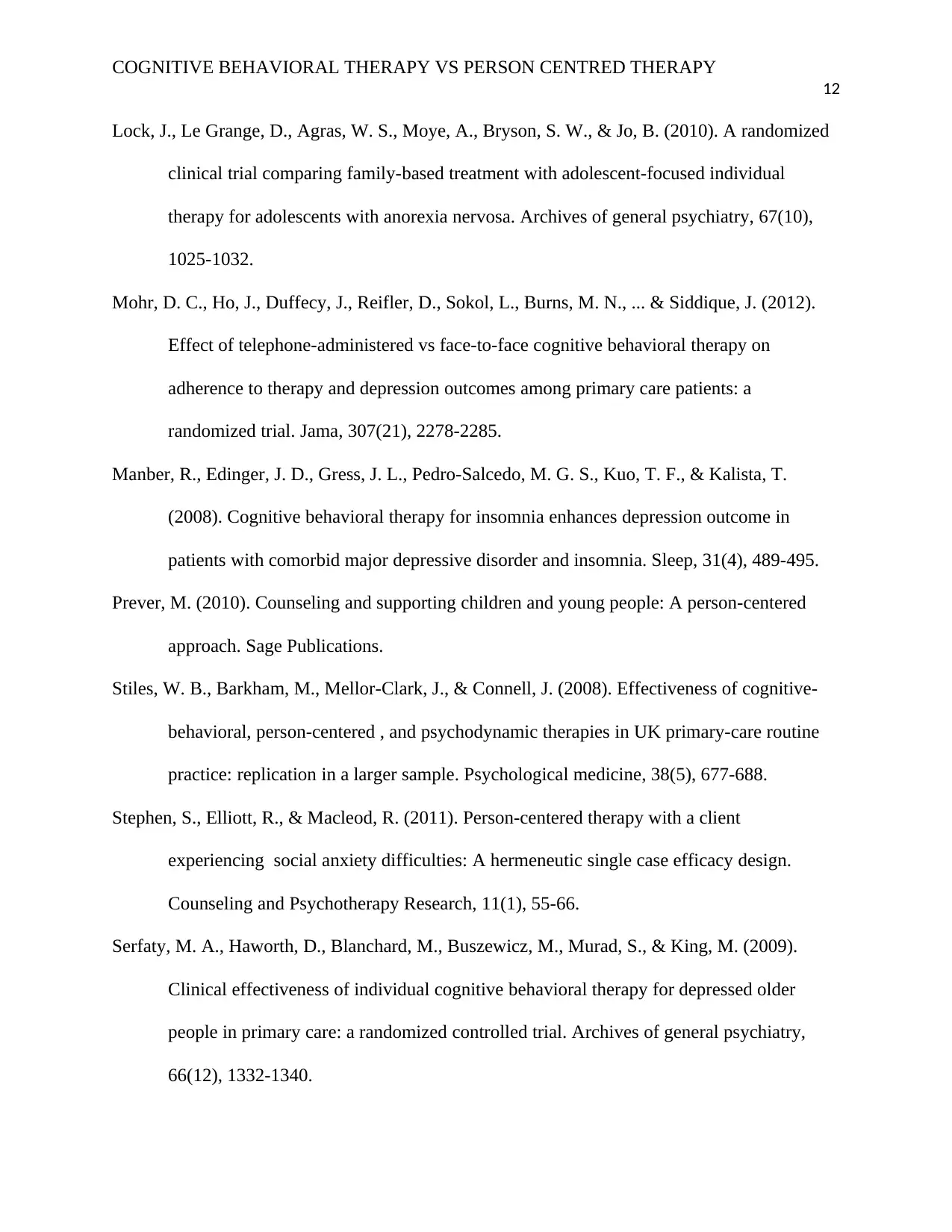
COGNITIVE BEHAVIORAL THERAPY VS PERSON CENTRED THERAPY
12
Lock, J., Le Grange, D., Agras, W. S., Moye, A., Bryson, S. W., & Jo, B. (2010). A randomized
clinical trial comparing family-based treatment with adolescent-focused individual
therapy for adolescents with anorexia nervosa. Archives of general psychiatry, 67(10),
1025-1032.
Mohr, D. C., Ho, J., Duffecy, J., Reifler, D., Sokol, L., Burns, M. N., ... & Siddique, J. (2012).
Effect of telephone-administered vs face-to-face cognitive behavioral therapy on
adherence to therapy and depression outcomes among primary care patients: a
randomized trial. Jama, 307(21), 2278-2285.
Manber, R., Edinger, J. D., Gress, J. L., Pedro-Salcedo, M. G. S., Kuo, T. F., & Kalista, T.
(2008). Cognitive behavioral therapy for insomnia enhances depression outcome in
patients with comorbid major depressive disorder and insomnia. Sleep, 31(4), 489-495.
Prever, M. (2010). Counseling and supporting children and young people: A person-centered
approach. Sage Publications.
Stiles, W. B., Barkham, M., Mellor-Clark, J., & Connell, J. (2008). Effectiveness of cognitive-
behavioral, person-centered , and psychodynamic therapies in UK primary-care routine
practice: replication in a larger sample. Psychological medicine, 38(5), 677-688.
Stephen, S., Elliott, R., & Macleod, R. (2011). Person-centered therapy with a client
experiencing social anxiety difficulties: A hermeneutic single case efficacy design.
Counseling and Psychotherapy Research, 11(1), 55-66.
Serfaty, M. A., Haworth, D., Blanchard, M., Buszewicz, M., Murad, S., & King, M. (2009).
Clinical effectiveness of individual cognitive behavioral therapy for depressed older
people in primary care: a randomized controlled trial. Archives of general psychiatry,
66(12), 1332-1340.
12
Lock, J., Le Grange, D., Agras, W. S., Moye, A., Bryson, S. W., & Jo, B. (2010). A randomized
clinical trial comparing family-based treatment with adolescent-focused individual
therapy for adolescents with anorexia nervosa. Archives of general psychiatry, 67(10),
1025-1032.
Mohr, D. C., Ho, J., Duffecy, J., Reifler, D., Sokol, L., Burns, M. N., ... & Siddique, J. (2012).
Effect of telephone-administered vs face-to-face cognitive behavioral therapy on
adherence to therapy and depression outcomes among primary care patients: a
randomized trial. Jama, 307(21), 2278-2285.
Manber, R., Edinger, J. D., Gress, J. L., Pedro-Salcedo, M. G. S., Kuo, T. F., & Kalista, T.
(2008). Cognitive behavioral therapy for insomnia enhances depression outcome in
patients with comorbid major depressive disorder and insomnia. Sleep, 31(4), 489-495.
Prever, M. (2010). Counseling and supporting children and young people: A person-centered
approach. Sage Publications.
Stiles, W. B., Barkham, M., Mellor-Clark, J., & Connell, J. (2008). Effectiveness of cognitive-
behavioral, person-centered , and psychodynamic therapies in UK primary-care routine
practice: replication in a larger sample. Psychological medicine, 38(5), 677-688.
Stephen, S., Elliott, R., & Macleod, R. (2011). Person-centered therapy with a client
experiencing social anxiety difficulties: A hermeneutic single case efficacy design.
Counseling and Psychotherapy Research, 11(1), 55-66.
Serfaty, M. A., Haworth, D., Blanchard, M., Buszewicz, M., Murad, S., & King, M. (2009).
Clinical effectiveness of individual cognitive behavioral therapy for depressed older
people in primary care: a randomized controlled trial. Archives of general psychiatry,
66(12), 1332-1340.
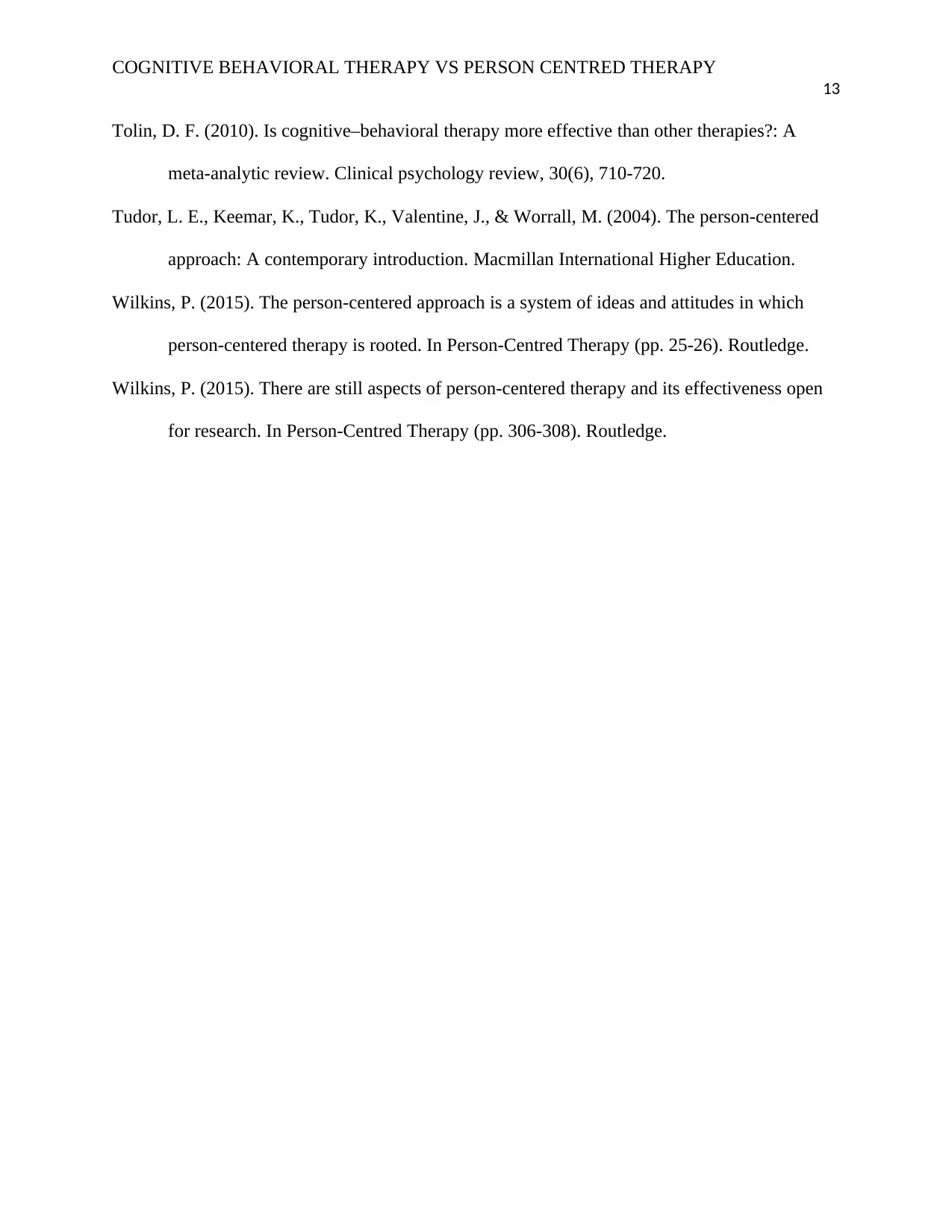
COGNITIVE BEHAVIORAL THERAPY VS PERSON CENTRED THERAPY
13
Tolin, D. F. (2010). Is cognitive–behavioral therapy more effective than other therapies?: A
meta-analytic review. Clinical psychology review, 30(6), 710-720.
Tudor, L. E., Keemar, K., Tudor, K., Valentine, J., & Worrall, M. (2004). The person-centered
approach: A contemporary introduction. Macmillan International Higher Education.
Wilkins, P. (2015). The person-centered approach is a system of ideas and attitudes in which
person-centered therapy is rooted. In Person-Centred Therapy (pp. 25-26). Routledge.
Wilkins, P. (2015). There are still aspects of person-centered therapy and its effectiveness open
for research. In Person-Centred Therapy (pp. 306-308). Routledge.
13
Tolin, D. F. (2010). Is cognitive–behavioral therapy more effective than other therapies?: A
meta-analytic review. Clinical psychology review, 30(6), 710-720.
Tudor, L. E., Keemar, K., Tudor, K., Valentine, J., & Worrall, M. (2004). The person-centered
approach: A contemporary introduction. Macmillan International Higher Education.
Wilkins, P. (2015). The person-centered approach is a system of ideas and attitudes in which
person-centered therapy is rooted. In Person-Centred Therapy (pp. 25-26). Routledge.
Wilkins, P. (2015). There are still aspects of person-centered therapy and its effectiveness open
for research. In Person-Centred Therapy (pp. 306-308). Routledge.
1 out of 13
Related Documents
Your All-in-One AI-Powered Toolkit for Academic Success.
+13062052269
info@desklib.com
Available 24*7 on WhatsApp / Email
![[object Object]](/_next/static/media/star-bottom.7253800d.svg)
Unlock your academic potential
© 2024 | Zucol Services PVT LTD | All rights reserved.



